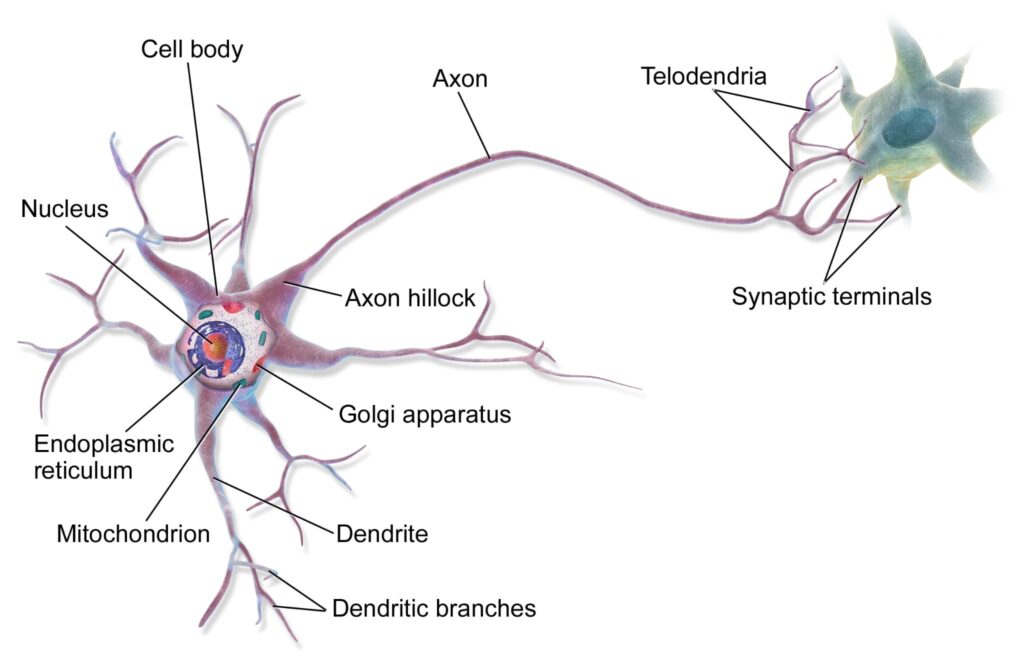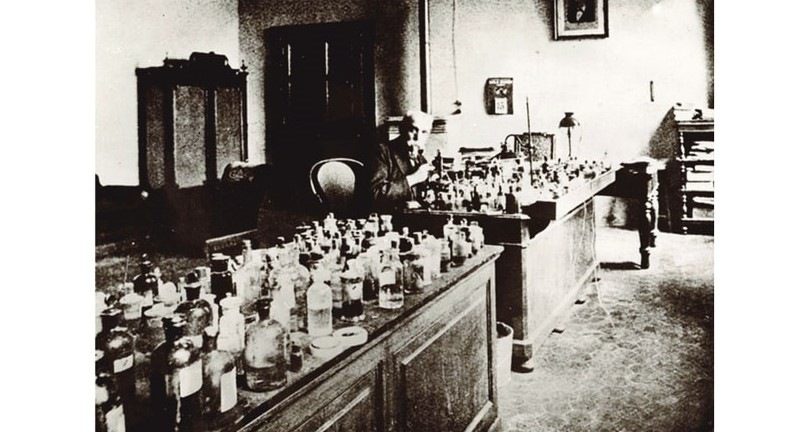Original article: Bartolomeo Camillo Emilio Golgi, by Ismael Sanchez Polanco
Biography
Bartolomeo Camillo Emilio Golgi was born on the 7th of July 1843 in Corteno, Italy. His father graduated in medicine in 1838 in Pavia, and he moved to Corteno to work as a general practitioner, where Golgi spent his youth. In 1850 he moved back to Pavia, and after two years, he attended the Gymnasium of Lovere, where he stayed for the following four years. He comes back to Pavia, where he obtained the high school diploma at Imperial Regio Ginnasio Liceale in 1860. In the same year, he enrolled at the faculty of medicine (Fig. 1).

The university studies
In 1865, he successfully graduated with the thesis of “Sull’eziologia delle malattie mentali” (the etiology of mental illnesses) discussed with Cesare Lombroso. After graduation, Golgi develops a strong interest in the nervous system thanks to Lombroso and Giulio Bizzozero, professor of General Pathology. The latter taught him experimental research based on the use of the microscope. The scientist became surgeon head physician at Ospedale Pie Case degli Incurabili di Abbiategrasso, in 1872. Golgi kept interests in histological research; in fact, he organizes a rudimentary laboratory in the kitchen of his flat and so the following year developed the “black reaction“. Finally, in 1876, he obtained the chair of histology at the University of Pavia. The next year he married Evangelina Aletti, Giulio Bizzozzero’s niece.
Golgi Political activity and the discovery of Golgi apparatus
Besides his scientific research, Camillo Golgi fulfills an essential political role. First became a councilor for hygiene at the municipality of Pavia and then grew into member and president of the Superior Council of Health. Moreover, he suggested the construction of the new Policlinico San Matteo of Pavia. Finally, Golgi filled the role of Rector of the University of Pavia. After five years, he could start his research activity again on the cell using the technique he had studied twenty-five years earlier. The research allowed him to discover the internal reticular apparatus, known by his name.
The Nobel Prize and the last years
In 1906 Golgi and Santiago Ramòn y Cajal won the Nobel Prize in Medicine and Physiology for their histological studies on the nervous system. In particular, Golgi won the price for the black reaction, while Cajal for the fact that the neurons are not contiguous. When the First World War broke out, Camillo Golgi directed the military hospital, placed in the antique Almo Collegio Borromeo of Pavia. He promoted the rehabilitation treatment for the war-wounded, building a center for rehabilitating the lesion to the peripheral nervous system.
He died in Pavia on 21 January 1926 and was buried in the monumental cemetery of Pavia, next to Adelchi Negri and Bartolomeo Panizza.
The black reaction
Camillo Golgi is best known because for his discovery of the endoplasmic reticulum. However, his studies were not limited to that. Among his firsts discoveries, there is “the black reaction”, a colorimetric method that made him won the Nobel Prize in 1906 (Video 1).
This optical microscopy technique allows the observation of different nervous system cells by coloring them with a characteristic black color, from which it takes the name “black reaction”. The reagents used were:
- Osmic acid;
- Potassium dichromate;
- Silver Nitrate.
Beyond improving the observation of the nerve cells, Golgi refuted Otto Freidrich Karl Deiters’s theory, Rudolf Virchow’s student, who claimed that the axon differed from dendrites for the absence of branches. Moreover, Golgi classified the neurons based on the length of the axon in two types:
- Neurons of Golgi’s first type are characterized from a very long axon;
- Golgi’s second type has a shorter axon that keeps dividing itself near the cell body (Fig. 2).

The diffuse nerve network
Bartolomeo Camillo Emilio Golgi, based on his findings of the neuron‘s morphology, developed the theory of the diffuse nerve network. This approach is aligned with the knowledge of the time on the nervous system. Golgi thought that it was the axons that fused with the dendrites from the observation of his slides. It should be added that the network thought by Golgi was not a homogeneous and invariant structure throughout the nervous system but had thickening and relaxation that should guarantee mechanisms of transmission between different regions.
The Golgi’s vision changed how the nervous system was seen: from a single system to a concept that took into account the parts. At the same time, the Spanish Santiago Ramòn y Cajal and the Flemish Arthur van Gehuchten developed the idea of “dynamic polarization” of the neurons, that is, the idea that the neuron has both a part of “reception” of nerve stimuli (cell body and dendrites) and a part of “emission” (axon). Despite these progressions, Camillo Golgi kept defending the model of “diffuse network”.
Golgi apparatus
Bartolomeo Golgi’s fame is mainly bound to the discovery of the organelle that bears his name. This will be confirmed fifty-seven years later by other scientists: Albert J. Dalton e Marie D. Felix through the electron microscope (Fig 3).
Golgi identified the organelle by using the technique he invented applied to nerve cells: through the optical microscope, in 1897, he discovered what he called “internal reticular apparatus“. Nevertheless, Golgi just described its morphology without making assumptions about its function. He waited one year before revealing his discovery, known in 1898 to the Medical-Surgical Society of Pavia (Società medico-chirurgica di Pavia). Later on, his pupils Adelchi Negri (1876 – 1912), Antonio Pensa (1874 – 1970), and Edoardo Gemelli (1878 – 1959) proved the presence of Golgi in cells not belonging to the nervous system.

Golgi and the studies on malaria
Golgi‘s research also focused on parasitology, in particular on malaria. His considerations were set out in the letter “On Malarial Infection” addressed to the pathologist Ettore Marchiafava and the hygienist Angelo Celli. First of all, Golgi was able to demonstrate that the two different types of malaria, the tertian and quartan, are caused by two different species of plasmodium:
- Plasmodium vivax: responsible for benign tertian fever;
- Plasmodium malariae: responsible for quartan fever.
Moreover, in 1889, Golgi demonstrated that fever attacks are linked to the moment in which the merozoites (a stage of the plasmodium cycle) break the erythrocytes and are released into the bloodstream.
The Golgi school
Many were the students who had Golgi as a teacher. They, influenced by their professor, dedicated themselves to research on the nervous system, microbiology, and the internal reticular apparatus. Some scientists are not very famous among his students, but not less important, because they increased Golgi’s fame as a teacher. They are listed below:
- Anna Kuliscioff;
- Rina Monti;
- Lina Luzzani;
- Costanza Boccadoro;
- Piera Locatelli.
Around 1900 Golgi had about thirty students (Fig.4 ).

Scientific contribution
Thanks to his discoveries, Bartolomeo Camillo Emilio Golgi made it possible to study nerve cells in a completely new and thorough way, using the “black reaction” and laying the groundwork for the in-depth study of the neurons. Moreover, thanks to his reflections on malaria, he could identify what corresponded to the fever peaks. The two types of malarial fever did not depend on the same Plasmodium species (Fig. 5).

Acknowledgments
National awards given to the scientist include:
- appointment as “corresponding member” of the Reale Accademia delle Scienze di Torino (1881);
- award of the prestigious Riberi prize of the Accademia di Medicina di Torino for his studies on malaria (January 5, 1893);
- appointment as senator of the Kingdom of Italy for high scientific merit by Umberto I (1900).
He went on earning two honors:
- Knight of Grand Cross decorated with Grand Cordon of the Order of Saints Maurice and Lazarus;
- Knight of the Civil Order of Savoy.
In addition to these awards, there are also foreign ones:
- the award of the Rinecker Prize, a prestigious international honor, by the German University of Würzburg (December 8, 1893);
- the award of the Elizabeth Thompson Fund by Harvard Medical School.
Golgi also obtained recognition for his work from his hometown, Corteno, which changed its name in honor of the scientist in 1956. On June 10, 2006, to celebrate the centenary of the Nobel Prize award, the “Camillo Golgi Museum” was founded. Inside, it is possible to observe the instruments and paper documents that certify the various phases of Golgi’s discoveries and intuitions (Fig.6 ).



In addition, a small crater on the Moon and an asteroid, Golgi 6875, discovered in 1994, were dedicated to Golgi.
Bibliography
- “Appunti di Storia della Medicina Pavese: Camillo Golgi” di Paolo Mazzarello
- “Golgi. A Biography of the Founder of Modern Neuroscience” di Paolo Mazzarello, Oxford University Press, Oxford. (2010)
- “Cytologic and cytochemical characteristics of the Golgi substance of epithelial cells of the epididymis–in situ, in homogenates and after isolation” A. J. Dalton Marie D. Felix, American Journal of Anatomy (March 1954)
- “Il Nobel dimenticato, la vita e la scienza di Camillo Golgi” di Paolo Mazzarello, Bollati Boringhieri Editore (2006)
Pictures Bibliography
- www.wikiwand.com/en/Camillo_Golgi
- en.wikipedia.org/wiki/Neuron
- it.wikipedia.org/wiki/Apparato_del_Golgi
- www.youtube.com/embed/JtZ7xQmgkp4?feature=oembed
- museocamillogolgi.unipv.eu/il-museo/approfondimenti/la-scuola-di-golgi/
- ucampus.unipv.it/camillo-golgi-protagonista-su-rai-storia-della-nuova-serie-italiani-nobel-minds/
- www.landmarksgallery.it/index.php?/tags/35-museo/start-15
- www.museogolgi.it/gallery.htm
Martina Calderato